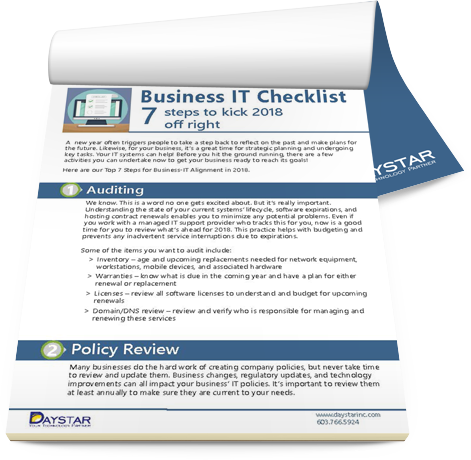IT costs money. Sometimes a lot of money. That’s why CIOs and IT managers are constantly searching for the best way to utilize their IT budget so it meets all their needs without emptying a bank account. To accomplish this, you can use an age-old business strategy: planning.
Cost structures are a financial management practice in all industries, but few people realize they can apply it to their IT services too. Adding an IT cost structure to your business processes will allow you to see where you’re spending your tech dollars, how much it costs you each month, and what opportunities for cost optimization exist.
In short, an IT cost structure can save you money.
When was the last time you checked in on your IT performance?
The Business IT Checklist shows you the 7 steps you need to take to enhance your business technology immediately.
What is an IT Cost Structure?
Just like a traditional cost structure, an IT cost structure tracks your IT spending. It’s like a cost calculator that adds up your operating costs, service fees, product purchases, and more over your spending period. So you might generate a report each month or each quarter that shows every line item expenditure from your IT budget.
These documents are particularly useful for budget planning because they can help you weigh your fixed costs against your variable costs. It’s easier to plan for fixed expenses, so discovering where your budget fluctuates and exploring possibilities for stabilization can help you make strategic IT decisions.
Why Does Efficiency Matter?
Understanding your spending is one thing, but managing your budget is something else entirely. That’s why efficiency is key. It’s not enough to know your actual costs, you also need a plan that will maximize those dollars. But unless you're an IT leader or have an IT team to consult, choosing the right mix of tactics is a difficult decision. You don’t know what’s worth the investment and what’s just padding to an already efficient system.
To help guide your planning, here are five things to focus on when creating an IT cost structure.
1. Track Your Spending
Before you make any adjustments to spending, you need a complete picture of where your money is going. The first step to creating a cost structure is to simply track your expenditures. Spend two billing cycles tracking your money to see where it goes. During this time, keep a close eye on variable costs and how much they vary and make a note of which costs are fixed.
Once you have a clear picture of what you’re investing in, check the metrics on those services. If you feel like any allocations aren’t matching the return you get, then you can use other companies as a benchmark. See how much similar businesses spend on that particular service to check if you’re in line with average costs or spending too much.
Tracking your spending will show you how much of your budget you dedicate to each IT cost and allow you to evaluate the worth of those services. You’d be surprised how often businesses are able to consolidate or eliminate unnecessary spending in this step.
2. Use the Cloud
Cloud storage has gained popularity for good reason. Not only does it cut down on physical equipment costs—servers with high-volume storage capabilities—it can also save you money on advanced cybersecurity measures and labor costs to protect your data in-house.
It’s also more convenient. With cloud storage, your information is housed in off-site data centers and available to you anywhere through the internet.
When it comes to cost planning, cloud services are typically billed monthly. There are two billing structures you’re most likely to encounter with providers:
- Per user.
You pay a fixed rate per user that will have access to your cloud data. For example, this might be the number of employees in your organization.
- By consumption.
You pay a variable rate based on how much storage space your business is using each month. This setup is similar to a gas or electricity bill; you pay for what you use.
3. Implement Automation and AI
Most modern management tools offer automation options. More advanced programs will go one step further and offer AI. These services can save you significant time and money on tasks that previously took up an employee’s entire day. Something as simple as automating virus scanning can aid in network safety and free an employee to focus on other business objectives.
Artificial intelligence isn’t as widespread as automation, but it’s quickly gaining ground. These programs can better analyze and evaluate your IT financial data and inform future initiatives. It can generate comprehensive reports on individual business units and make suggestions based on your established goals, cost modeling, or main objectives.
Automation and AI cost more than manual systems, but they’re examples of technology investments that create returns in your workforce. They eliminate the need for dedicating employees to repetitive tasks and free up your workforce to focus on core competencies in your business.
4. Outsource IT Management

In-house IT departments are huge cost drivers for small businesses. It’s not practical to keep IT professionals on your payroll, but that doesn’t mean you should go without support. Outsourcing IT services to a managed service provider typically saves businesses 40% or more on their IT costs.
When you work with an IT company, you have access to a team of experts with the qualifications and equipment to effectively manage and protect your business. This partnership gives small businesses access to enterprise-level technology at a fraction of the cost, which makes them more competitive.
This method also provides you with a direct cost for all of your IT needs. Most service providers calculate fixed prices based on the services you opt into. You can add or remove services as needed so your service evolves with your business. Signing a contract with an IT company means you can easily predict your future spending and see exactly how those dollars are utilized.
5. Reduce Variable Costs
Whether it’s through activity-based costing or assigning values to changing percentages, variable costs make it difficult to budget. You can’t draw a roadmap if the streets are constantly changing direction, and you can’t create an efficient IT cost structure if your costs are always in flux.
For this reason, you want to reduce your variable costs as much as possible. It makes it easier to anticipate monthly expenditures and strategically plan your investments. Fixed costs also make it easier to anticipate your needs and defend the need for a minimum budget amount.
There will always be a few costs that are variable by nature, and that’s okay. Continue monitoring those during each billing period to see if there are significant changes month-to-month or if they remain fairly constant. If there are excessive spikes and dips making cost planning difficult, brainstorm a few ways you could make that service more efficient or the billing more stable. Examples include switching to cloud storage, outsourcing IT, or finding another service provider that offers fixed rates.
6. Integrate IT and Finance
The last technique that helps tremendously when creating a cost structure is including both IT and finance leaders in the process. The CFO or controller of a business is close to the ins and outs of the company’s overall fiscal demands, resources, and opportunities. While the IT manager or CIO stays on top of strategic IT priorities and potential opportunities to control costs across projects, vendors, technology systems, and more.
These two professionals comprise both sides of the cost structure coin. When they work together, your business can make smarter decisions that are informed by overall needs as well as IT needs. This means you can create an IT cost structure that benefits the company and your bottom line.
At Daystar, we’re experts in IT budget planning and efficient cost structuring. If you need help managing your IT costs, contact us today!














